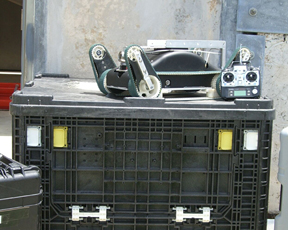US&R Rescue Robots
Vital Data Requirements for Use of Search and Rescue Robots

Feb 5, 2008, News Report
Photo: Urban search and rescue robot and its control unit sit atop one of the packing crates stipulated in a new ASTM International standard designed to help first responders manage storage and transportation logistics. Photo credit: NIST
A new ASTM International standard for urban search and rescue robots and components tackles humble logistics problems that, left unsolved, could hamper the use of life-saving robots in major disasters. The advance, formally agreed to recently, is one result of a three-year National Institute of Standards and Technology (NIST) coordinated effort with first responders and robot manufacturers to develop urban search and rescue robot consensus standards. The new standard details specific ways to describe requirements for the storage, shipping and deployment of urban search and rescue robots.
Sensor-laden robots, ranging from ball-shaped survey devices that can be thrown into disaster sites to radio-operated crawlers capable of exploring ruins and even rotary-winged aerial reconnaissance drones, are recognized as holding tremendous potential as additions to the responder's toolkit. The new voluntary standard reflects a priority expressed in a series of NIST-coordinated workshops to accelerate the development and deployment of such urban search and rescue robots and components. Federal Emergency Management Agency (FEMA) regional task force members and other first responders, technology developers and robot vendors said that access to standardized information concerning urban search and rescue robot logistics attributes would help response team managers integrate the devices into their operations.
A standard data form lists information relevant to robots that would be deployed for 10 days without re-supply for the first 72 hours. Seemingly mundane but essential information--the number and types of cases required for packing the robot and all associated components (such as sensors, tethers, operator control stations spare parts and specialized tools), for instance--should enable logistics managers to allocate appropriate warehouse space as well as transportation accommodations for shipment to and from the disaster site. Estimates on the time required to unpack, set up and repair units also will help potential users estimate a realistic time to deployment. Finally data on the actual weight of the robots and its components should allow users to plan how to transport the devices to the worksite from the base of operations.
Further information on NIST's urban search and rescue robot performance standards project, which is sponsored by the Department of Homeland Security (DHS) Science and Technology Directorate, can be found at www.isd.mel.nist.gov/US&R_Robot_Standards.
Specialty Websites
Find Members Fast
Firefighting Videos
© 2025 Created by Firefighter Nation WebChief.
Powered by
![]()
Badges | Contact Firefighter Nation | Privacy Policy | Terms of Service
You need to be a member of My Firefighter Nation to add comments!
Join My Firefighter Nation